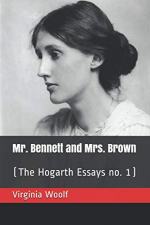|
This section contains 616 words (approx. 2 pages at 400 words per page) |

|
Mr. Bennett and Mrs. Brown Summary & Study Guide Description
Mr. Bennett and Mrs. Brown Summary & Study Guide includes comprehensive information and analysis to help you understand the book. This study guide contains the following sections:
This detailed literature summary also contains Topics for Discussion on Mr. Bennett and Mrs. Brown by Virginia Woolf.
The following version of this essay was used to create this guide: Woolf, Virginia. "Mr. Bennett and Mrs. Brown." Project Gutenberg Online. http://www.gutenberg.org/files/63022/63022-h/63022-h.htm.
Note that all parenthetical citations refer to the page number on which the quotation appears.
Virginia Woolf begins her essay by announcing that in her work as a novelist, she often encounters "the figure of a man, or of a woman, who said, 'My name is Brown. Catch my if you can'" (1). Woolf explains that this figure is a character who entices the author to write about them, but that few novelists ever actually achieve a complete portrait. Next, Woolf alludes to the words of a fellow novelist, Arnold Bennett, who says that the fundamental aspect of good fiction is the creation of realistic and convincing characters, but that the writers of the contemporary moment are unable to achieve that end. Woolf immediately declares that she wishes to dispute Bennett's claim. She divides writers into two camps – the Edwardians and the Georgians – and says that a major shift in "human character" occurred around December of 1910, which she sees as the dividing line between these two kinds of writers (1). Society became more integrated, she says, and therefore literature shifted in that direction as well. She then recounts an anecdote about encountering two people on a train, one of whom – an older woman – she refers to as "Mrs. Brown." Woolf was intrigued by Mrs. Brown immediately but was not entirely privy to the details of the conversation Mrs. Brown had with her traveling companion.
Woolf uses Mrs. Brown as an example of a character "imposing" themselves on a writer (4). She admits that she herself felt almost forced to write a novel about this intriguing woman. Mrs. Brown, she explains, would be represented differently depending on the country from which the writer originates, but she is nonetheless a character of "infinite variety" (5). Woolf returns to Bennett's claim that writers must right realistic characters and poses the questions, "what is reality? And who are the judges of reality?" (5). Next, she launches into an analysis of the Edwardian writers, explaining how each of the major authors would have structured novels about Mrs. Brown. She ends with a close reading Arnold Bennett's novel Hilda Lessways, and criticizes his work for being so concerned with context and exposition that the representation of character fails to exist at all. She accuses Bennett of "trying to make us imagine for him" (8).
She does, however, excuse Bennett by explaining that he was merely relying upon the literary conventions of his time. These conventions, however, no longer exist for the Georgian writers, and they are therefore presented with the problem of how to write characters in new ways. She explains that early Georgians like D.H. Lawrence and E.M. Forster tried to use the conventions of the Edwardians, and thus their early work suffered. Other Georgians like James Joyce and T.S. Eliot represent, for Woolf, more experimental work that challenges the reader but ultimately showcases the predicament of representation in which contemporary writers find themselves. She asks her audience to remain patient as the current literary moment unfolds, and to accept "a season of failures and fragments" as the novelists discover new ways to write (11). She cautions them against believing that writers are the only ones capable of defining the current literary moment, and encourages them to participate in the search for "Mrs. Brown." She ends her essay by looking forward, saying, "we are trembling on the verge of one of the great ages of English literature. But it can only be reached if we are determined never, never to desert Mrs. Brown" (12).
Read more from the Study Guide
|
This section contains 616 words (approx. 2 pages at 400 words per page) |

|



